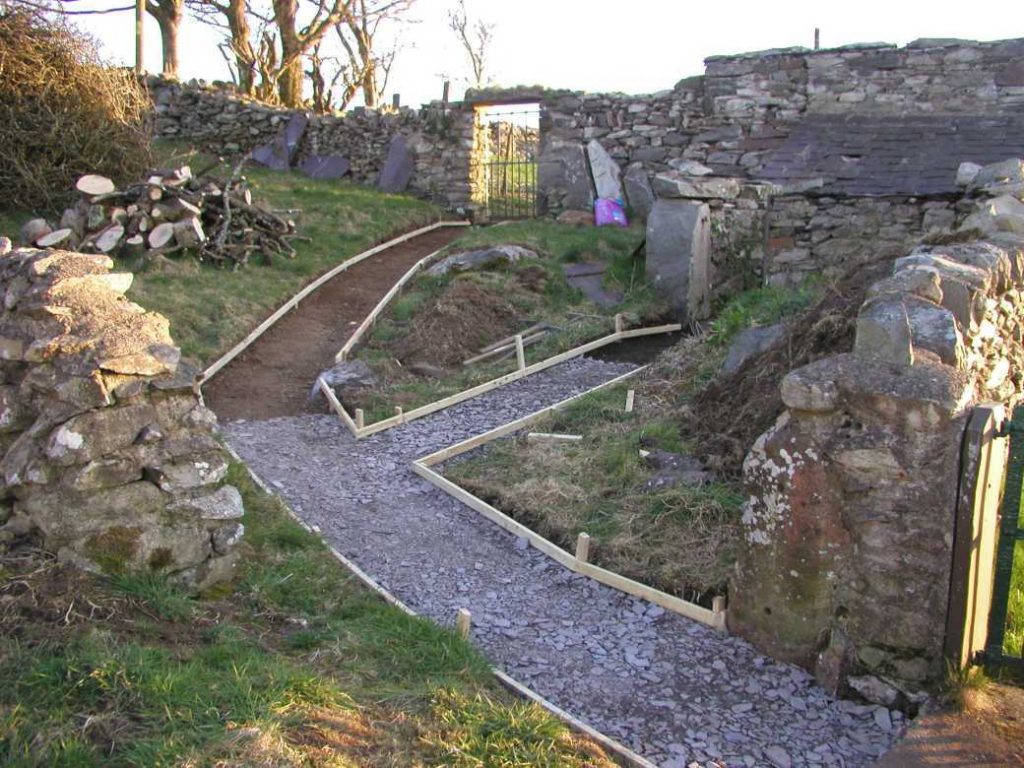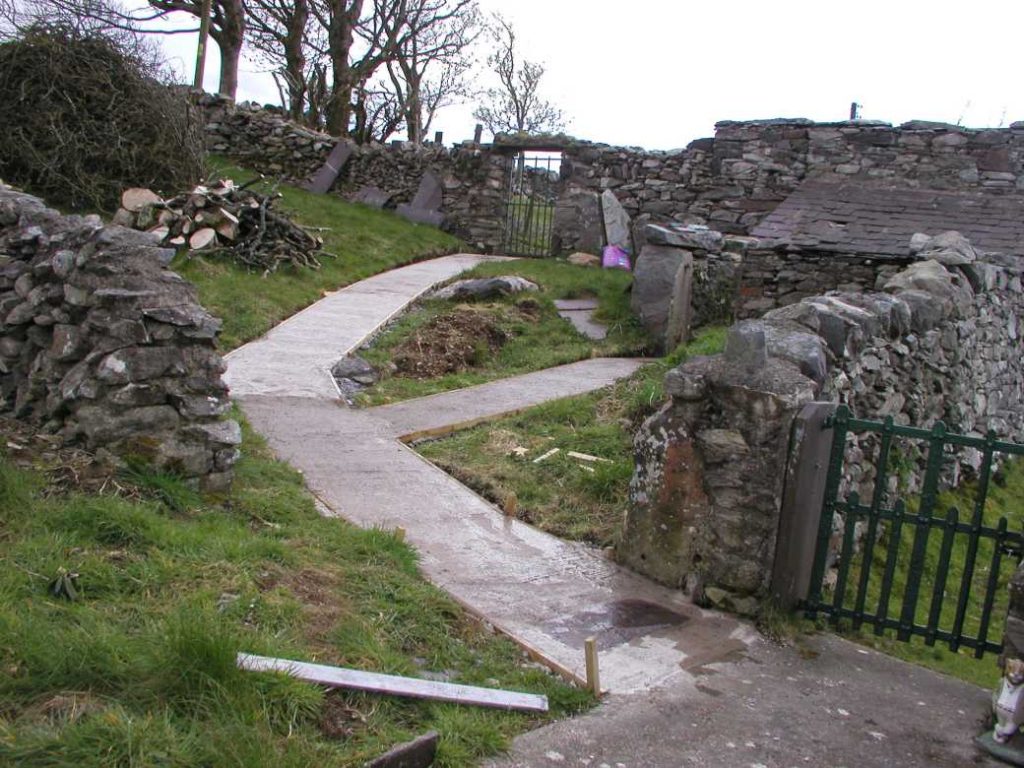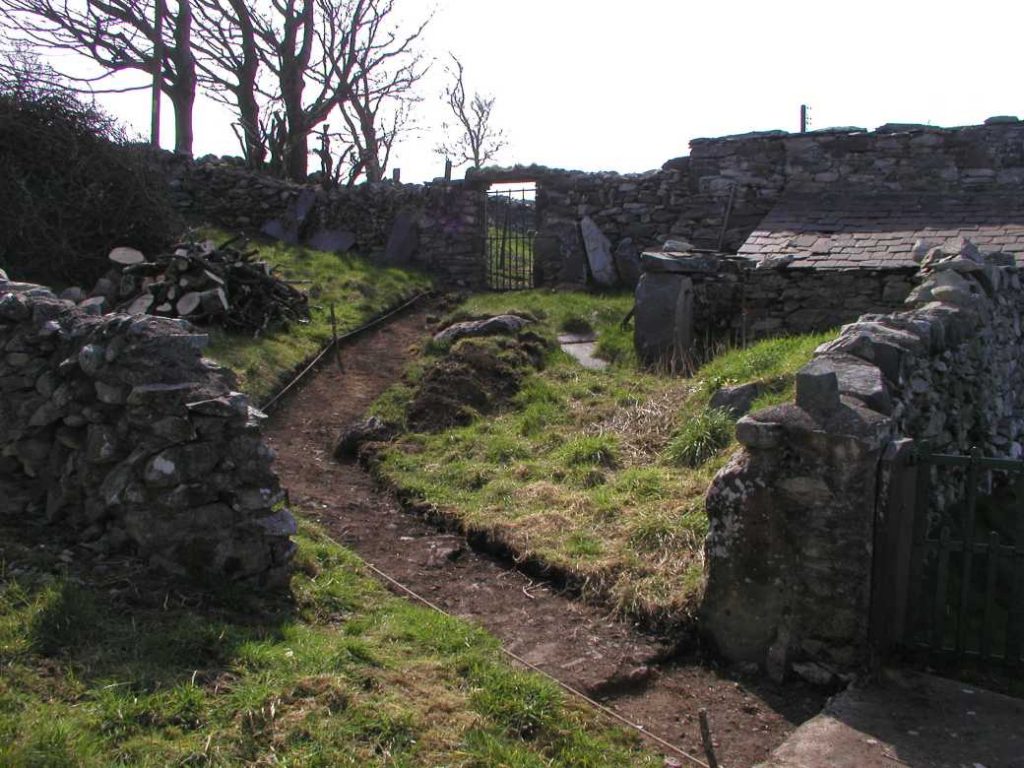This guide is designed to be read in conjunction with the article How to Build a Concrete Path that covers the details. This photo guide should give you a quick over view of the process.
Step by Step Guide To Building Concrete Path
Preparation – Marking & Digging Out the Path
Mark out with string and stakes where the path is to go, following the natural route where you actually walk. Then dig out the topsoil to a depth of 15cm (6″) or so. If stripping turf, stack that upside down to rot down into usable loam to use elsewhere.
If your soil is particularly loose then you may need to go down a little further to ensure the path is stable.
Laying a Base of Aggregate
Put down a layer of aggregate on the base of the path. The final level should be about 5cm for light use and 7.5cm for heavy use, below the finished surface level of the path. Fix wooden battens to the sides. The tops of the battens should equal the top of path. Slope slightly from side to side so that water runs off with level paths.
In this case we’ve used slate waste for the aggregate. Tamp the aggregate down well or, with a long path, hire a vibrating (whacker) plate for a day.
Fill with Concrete and Tamp Out
Fill with concrete to above the side battens and then tamp down as described above to drive any air out of the concrete. Allow expansion joints as described above every 3 metres of run on the path.
Protect with plastic or suchlike in hot weather to avoid the concrete drying too quickly and in frosty weather to avoid damage from freezing.
Adding a Decorative touch to the Concrete Path
One final touch was to lay a slate slab into the concrete at the top and bottom of the path. This serves little practical purpose but does make the path look less Spartan. The path could be edged with bricks laid side-on if you wished.
Some cobbles could be set in or even some patterns from bricks. Although the path is practical there is no reason not to make it a positive feature. Leave the concrete slightly rough or ridged for better grip in wet weather.
Concrete Calculation Quick Guide Memo
Aggregate
Aggregate – to calculate cubic volume simply multiply length by width by depth and add 20% to allow for compaction.
Example 3.6 metre long path, 90cm wide and 5cm deep. Turn into same units = 3.6 x 0.9 x 0.05 = 0.162 add 20% (multiply by 1.2) = 0.1944 cubic metres Call it 0.2 or a fifth of a cube.
Concrete
Calculate the cubic volume required using length x width x depth
Concrete Mixes for Path:
1 part cement to 4 parts all in aggregate (10mm max)
or
1 part concrete, 2 parts sand, 3 parts coarse aggregate (10mm max).
For a cubic metre of concrete you’ll need 13 25Kg bags of cement and about 0.75 m3 of all in aggregate.
Growing Guides, Information & Articles
- 3 Creative Ways To Beautify Your Garden
- 6 Ways to Enjoy Your Garden More This Summer
- Cats Toileting: How to Stop Cats using Garden or Veg Plot as a Toilet
- Desert Botanical Garden – what makes it so special?
- Full Spectrum Light – Grow Lighting using LED
- Garden Hints & Tips
- Garden Pests – Rabbits, Deer, Pigeons, Badgers
- How Fast Does Cherry Laurel Grow?
- How Inflatable Hot Tubs Improve Your Garden Ten Fold
- How to Care for a Peace Lily Indoors: Step-by-Step Guide
- How to Get the Most Out of Your Garden
- How To Give Your Garden A Makeover During Lockdown
- How to Grow Gladiolus in Your Garden
- How To Make A Side Income From Your Garden
- How to Protect Your Vegetable Garden from the Wind
- How to take care of your pond
- Microgreens – How to Grow Micro-greens Winter & Summer
- Modern Garden Ideas Featuring an Outdoor Firepit
- Planning a garden or allotment clearance
- Redesigning flower beds – How to do it
- Repair Rather Than Replace Old Garden Machinery and Power Tools
- Starting Them Young: 6 Homesteading Skills to Teach Children
- The Role of Campus Gardens in Student Mental Health and Well-being
- Top tips for amateur gardeners: get started today
- Why are LED Horticultural Grow Lights Purple?
- Zen Garden for Meditative Space
- Best Temperatures for Seed Germination
- Raised Beds – Vegetable Growing in Raised Beds
- Seed Saving
- Lawn Care Guides and Advice
- 10 Ways to Increase the Aesthetic Appeal of Your Backyard
- Fluid Seed Sowing & Seed Pre-Germination
- Home Made Pesticides & Unlicensed Use of Pesticides
- Decorative Garden Arches – Roman, Gothic, Ogee Garden Arches
- 5 Popular Uses for Log Cabins
- Grow Your Own Vegetables, Fruit, Herbs & Nuts
- Weed Control
- Gardening And The Importance Of Water Quality
- How to Build a Concrete Garden Path
- Concrete Garden Path Construction – Step by Step Photo Guide
- How Can Gardeners Cope with Climate Change?
- Gardening & Growing Vegetables Under a Hosepipe Ban
- Water Conservation: Garden Techniques
- Flood! Safe Growing & Harvesting of Crops After a Flood
- Day Length and Growing Plants
- Gardener’s Back Pain – Look After Your Back in the Garden
- Become an Urban Farmer and Start Growing Potted Plants
- Allotment Vegetable Plot Planning Software
- Start Your Seeds Indoors For A Jump On Spring Planting
- An Eco-Friendly Garden Backyard – Green Gardening
- Lunar Gardening, planting and gardening according to the phase of the Moon




